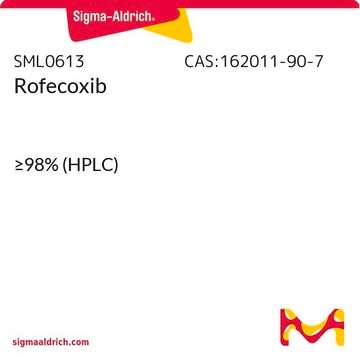41346
2-Phenethylamine
analytical standard
Synonim(y):
β-Phenylethylamine, 2-Phenylethylamine
About This Item
Polecane produkty
klasa czystości
analytical standard
Poziom jakości
gęstość pary
4.18 (vs air)
Próba
≥99.0% (GC)
okres trwałości
limited shelf life, expiry date on the label
metody
HPLC: suitable
gas chromatography (GC): suitable
współczynnik refrakcji
n20/D 1.533 (lit.)
n20/D 1.534
tw
197-200 °C (lit.)
gęstość
0.962 g/mL at 20 °C (lit.)
Zastosowanie
cleaning products
cosmetics
environmental
flavors and fragrances
food and beverages
personal care
format
neat
ciąg SMILES
NCCc1ccccc1
InChI
1S/C8H11N/c9-7-6-8-4-2-1-3-5-8/h1-5H,6-7,9H2
Klucz InChI
BHHGXPLMPWCGHP-UHFFFAOYSA-N
Szukasz podobnych produktów? Odwiedź Przewodnik dotyczący porównywania produktów
Opis ogólny
Zastosowanie
Hasło ostrzegawcze
Danger
Zwroty wskazujące rodzaj zagrożenia
Zwroty wskazujące środki ostrożności
Klasyfikacja zagrożeń
Acute Tox. 3 Oral - Eye Dam. 1 - Met. Corr. 1 - Skin Corr. 1B
Kod klasy składowania
6.1A - Combustible acute toxic Cat. 1 and 2 / very toxic hazardous materials
Klasa zagrożenia wodnego (WGK)
WGK 1
Temperatura zapłonu (°F)
177.8 °F - closed cup
Temperatura zapłonu (°C)
81 °C - closed cup
Środki ochrony indywidualnej
Faceshields, Gloves, Goggles, type ABEK (EN14387) respirator filter
Choose from one of the most recent versions:
Masz już ten produkt?
Dokumenty związane z niedawno zakupionymi produktami zostały zamieszczone w Bibliotece dokumentów.
Klienci oglądali również te produkty
Nasz zespół naukowców ma doświadczenie we wszystkich obszarach badań, w tym w naukach przyrodniczych, materiałoznawstwie, syntezie chemicznej, chromatografii, analityce i wielu innych dziedzinach.
Skontaktuj się z zespołem ds. pomocy technicznej










